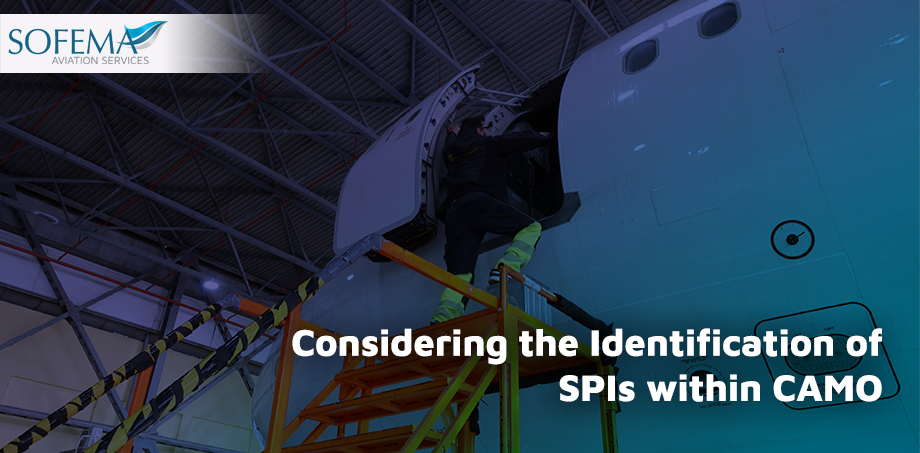Sofema Aviation Services (SAS) considers the key safety indicators for effective engagement with SMS Safety Performance Indicators (SPI’s) within the CAMO business area.
Safety Performance Indicators (SPIs) are metrics used to measure the effectiveness of safety processes and help identify areas needing improvement within an organization.
In an EASA Continuing Airworthiness Management Organization (CAMO), which bridges the gap between operations and maintenance, identifying and managing SPIs is crucial for ensuring the continued safety and airworthiness of the fleet.
Here are Some Key Points and Practical Examples:
As the CAMO serves as an intermediary between operations and maintenance, it is responsible for planning, managing, and ensuring that all maintenance activities are aligned with regulatory requirements and the airline’s operational needs.
- Regulatory Compliance: CAMO must ensure compliance with EASA regulations while tailoring safety programs to the unique needs of their fleet and operational context.
- Effective communication between operations and maintenance departments is crucial to provide meaningful data for SPIs and translate findings into actionable safety measures.
Examples of SPIs in CAMO:
Implementing and monitoring these SPIs requires a robust data management system and a safety-oriented organizational culture. CAMO should establish regular review mechanisms, with relevant stakeholders across operations and maintenance, to assess SPI data and ensure continuous improvement.
- CAMO Compliance Audit Findings
o Number of Discrepancies found during Audit – per Audit Cycle
- Deferred Defects Management
o Indicator: Number of deferred defects per aircraft over a specific time period.
- Maintenance Findings and Recurring Issues
o Indicator: Frequency of repetitive technical issues or maintenance findings
- Maintenance Schedule Compliance
o Percentage of maintenance tasks completed on schedule.
- Technical Incidents
o Indicator: Rate of technical incidents per flight hour or flight cycle.
- Maintenance Errors
o Indicator: Rate of maintenance errors or procedural deviations reported.
- Airworthiness Directives (AD) Compliance
o Timeliness of implementing mandatory ADs.
- Communication and Coordination Efficiency
o Frequency and quality of communication between CAMO and other departments.
- Component Reliability Analysis
o Failure rate of critical components per flight cycle or operational hour.
- Maintenance Program Efficiency
o Percentage of planned vs. unplanned maintenance tasks.
- Parts Supply Chain Compliance
o Frequency of parts delivery delays impacting maintenance schedules.
- Fleet Availability Rate
o Percentage of aircraft available for operation out of the total fleet.
- Training Compliance
o Percentage of CAMO staff who completed required training on time.
- Occurrence Reporting External & Internal
o Effectiveness of the Reporting Systems – Related to the actual reporting rate related to the evidence of exposure due to compliance and safety audit findings.
- Scheduled Maintenance Workload Balance
o Distribution of maintenance tasks across maintenance teams or shifts.
Challenges:
- Accurate data is essential for effective decision-making. Inconsistent data sources, insufficient data management systems, or delayed updates can lead to errors in planning and risk assessments.
o Implementing integrated digital data management systems that facilitate real-time data sharing and reporting.
- Coordination between CAMO, Operations, and Maintenance – Miscommunication or lack of understanding between CAMO, maintenance, and operations departments can lead to safety issues or inefficiencies.
o Develop cross-functional training programs and enhance communication channels to foster collaboration.
- Errors due to fatigue, inadequate training, or complacency can compromise safety.
o Implement a comprehensive training program, including human factors awareness, and ensure adequate rest periods for staff.
Additional Resources – Please see the following link to the SAS downlod area = EASA Aviation Safety Management System Risk Register Development
Next Steps
Follow this link to our Library to find & Download related documents for Free.
Sofema Aviation Services (SAS) and Sofema Online (SOL) provide Safety and Risk Management Training as Classroom, webinar or online. Please see the websites or email team@sassofia.com
Tags:
Maintenance, Airworthiness, SAS blogs, Safety Performance Indicators, Audit Findings, Supply Chain Compliance, EASA regulatory compliance, EASA Continuing Airworthiness Management Organizations, Continuing Airworthiness Management Organizations, CAMO business area, Safety Performance Indicators (SPIs), Airworthiness Directives (AD), Risk Management Training




